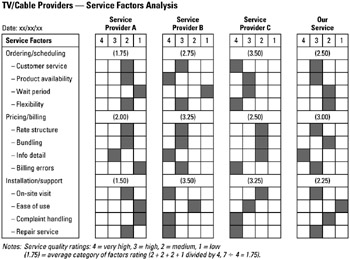Tool 73: Factor Analysis
| AKA | N/A |
| Classification | Evaluating/Selecting (ES) |
Tool description
A factor analysis is an assessment technique that surfaces product, process, or service factors that may require immediate attention or further analysis. Similar to benchmarking, product and/or service factor ratings are compared to best in class or to one's own organization to determine competitive strengths and weaknesses.
Typical application
-
To assess best in class processes.
-
To compare product and service ratings with those of the competition.
-
To identify problem areas for the assignment to problem-solving teams.
Problem-solving phase
| → | Select and define problem or opportunity |
| → | Identify and analyze causes or potential change |
| Develop and plan possible solutions or change | |
| → | Implement and evaluate solution or change |
| Measure and report solution or change results | |
| Recognize and reward team efforts |
Typically used by
| Research/statistics | |
| 2 | Creativity/innovation |
| 1 | Engineering |
| Project management | |
| Manufacturing | |
| 3 | Marketing/sales |
| Administration/documentation | |
| Servicing/support | |
| Customer/quality metrics | |
| 4 | Change management |
before
-
Benchmarking
-
Matrix data analysis
-
Linking diagram
-
Customer needs table
-
Organization readiness chart
after
-
SWOT analysis
-
Gap analysis
-
Radar chart
-
SCAMPER
-
Value analysis
Notes and key points
-
Factorial ratings can reflect customer satisfaction, best practices, overall quality, design, or process categories.
-
Optional ratings: 4 = very high; 3 = high; 2 = medium; 1 = low. Other rating scales can be used.
-
The overall or category of factors rating is an average of all factor ratings within a particular category.
Step-by-step procedure
-
STEP 1 An integrated product development team (IDPT) selects the most important product or service factors to be analyzed. See example TV/Cable Providers—Service Factors Analysis.
-
STEP 2 Next, competitors are identified for data collection on the selected factors. Sources of data are customer satisfaction surveys, benchmarking partnerships, secondary data, interviews, documentation, and others.
-
STEP 3 Data from competitors and one's own organization are verified, rated, and organized into category of factors groupings.
-
STEP 4 A factor analysis table is constructed and ratings recorded for each listed factor. Also, a category of factors average is calculated and recorded.
-
STEP 5 Finally, the factor analysis table is checked for completeness, dated, and presented to the respective process owners.
Example of tool application

EAN: 2147483647
Pages: 326